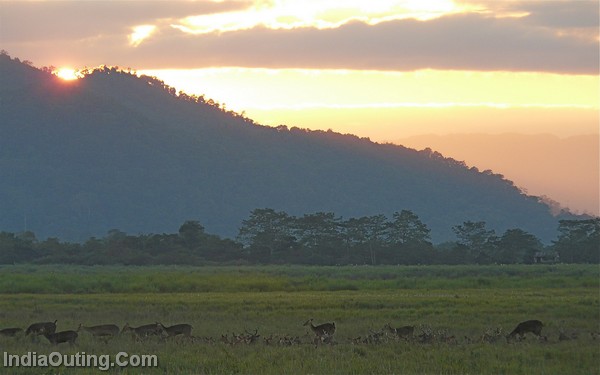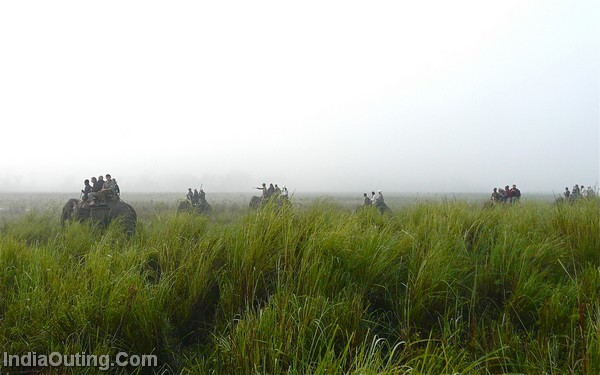Kaziranga National Park (Assamese: কাজিৰঙা ৰাষ্ট্ৰীয় উদ্যান, Kazirônga Rastriyô Uddan, ) is a national park in the Golaghat and Nagaon districts of the state of Assam, India. A World Heritage Site, the park hosts two-thirds of the world’s Great One-horned Rhinoceroses. Kaziranga boasts the highest density of tigers among protected areas in the world and was declared a Tiger Reserve in 2006. The park is home to large breeding populations of elephants, wild water buffalo, and swamp deer.Kaziranga is recognised as an Important Bird Area by Birdlife International for conservation of avifaunal species. Compared to other protected areas in India, Kaziranga has achieved notable success in wildlife conservation. Located on the edge of the Eastern Himalaya biodiversity hotspot, the park combines high species diversity and visibility.Kaziranga is a vast expanse of tall elephant grass, marshland, and dense tropical moist broadleaf forests, crisscrossed by four major rivers, including the Brahmaputra, and the park includes numerous small bodies of water. Kaziranga has been the theme of several books, songs, and documentaries. The park celebrated its centennial in 2005 after its establishment in 1905 as a reserve forest.
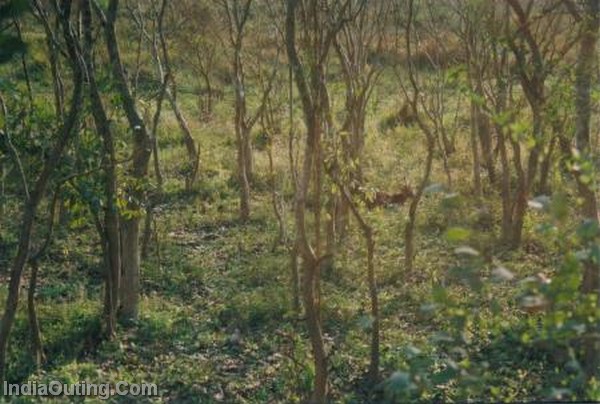





History
The history of Kaziranga as a protected area can be traced back to 1904, when Mary Victoria Leiter Curzon, the wife of the Viceroy of India, Lord Curzon, visited the area. After failing to see a single rhinoceros, for which the area was renowned, she persuaded her husband to take urgent measures to protect the dwindling species which he did by initiating planning for a their protection. On 1 June 1905, the Kaziranga Proposed Reserve Forest was created with an area of 232 km2 (90 sq mi).Over the next three years, the park area was extended by 152 km2 (59 sq mi), to the banks of the Brahmaputra River. In 1908, Kaziranga was designated a Reserve Forest. In 1916, it was converted to a game sanctuary—The Kaziranga Game Sanctuary—and remained so till 1938, when hunting was prohibited and visitors were permitted to enter the park.The Kaziranga Game Sanctuary was renamed the Kaziranga Wildlife Sanctuary in 1950 by P. D. Stracey, the forest conservationist, in order to rid the name of hunting connotations. In 1954, the government of Assam passed the Assam (Rhinoceros) Bill, which imposed heavy penalties for rhinoceros poaching. Fourteen years later, in 1968, the state government passed ‘The Assam National Park Act of 1968′, declaring Kaziranga a designated national park.The 430 km2 (166 sq mi) park was given official status by the central government on 11 February 1974. In 1985, Kaziranga was declared a World Heritage Site by UNESCO for its unique natural environment.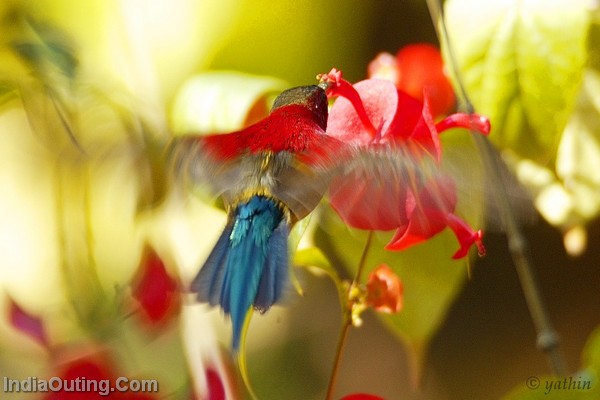
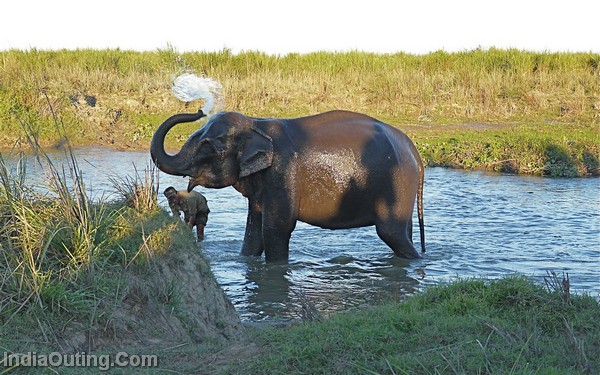
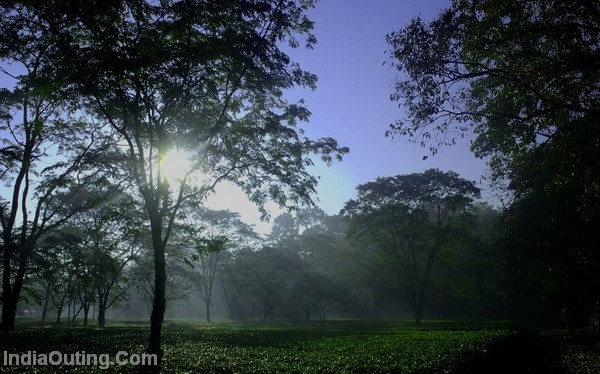



Climate
The park experiences three seasons: summer, monsoon, and winter. The winter season, between November and February, is mild and dry, with a mean high of 25 °C (77 °F) and low of 5 °C (41 °F). During this season, beelsand nallahs (water channels) dry up. The summer season between March and May is hot, with temperatures reaching a high of 37 °C (99 °F). During this season, animals usually are found near water bodies. The rainy monsoon season lasts from June to September, and is responsible for most of Kaziranga’s annual rainfall of 2,220 mm (87 in). During the peak months of July and August, three-fourths of the western region of the park is submerged, due to the rising water level of the Brahmaputra. The flooding causes most animals to migrate to elevated and forested regions outside the southern border of the park, such as the Mikir hills. However, occasional dry spells create problems as well, such as food shortages for the wildlife in the park.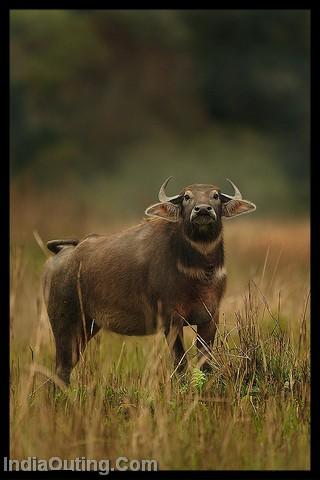
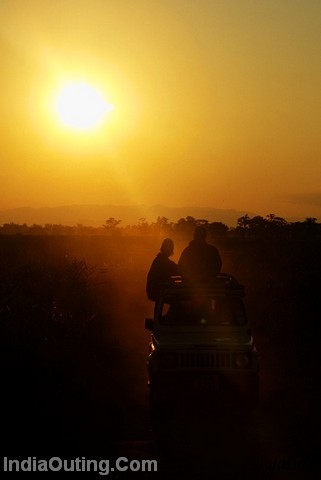
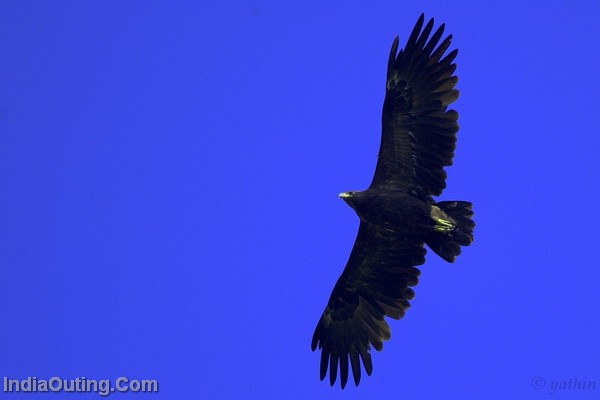





Transport
Authorised guides of the forest department accompany all travellers inside the park. Mahout-guided elephant rides and Jeep or other 4WD vehicles rides are booked in advance. Starting from the Park Administrative Centre at Kohora, these rides can follow the three motorable trails under the jurisdiction of three ranges—Kohora, Bagori, and Agaratoli. These trails are open for light vehicles from November to mid-May. Visitors are allowed to take their own vehicles when accompanied by guides.Buses owned by Assam State Transport Corporation and private agencies between Guwahati, Tezpur, and Upper Assam stop at the main gate of Kaziranga on NH-37 at Kohora. The nearest town is Bokakhat 23 kilometres (14 mi) away. Major cities near the park are Guwahati (217 kilometres (135 mi)) and Jorhat (97 kilometres (60 mi)). Furkating 75 kilometres (47 mi), which is under the supervision of Northeast Frontier Railway, is the nearest railway station. Jorhat Airport at Rowriah (97 kilometres (60 mi) away), Tezpur Airport at Salonibari (approx 100 kilometres (62 mi) away), and Lokpriya Gopinath Bordoloi International Airport in Guwahati (approximately 217 kilometres (135 mi) away) are the nearby airports.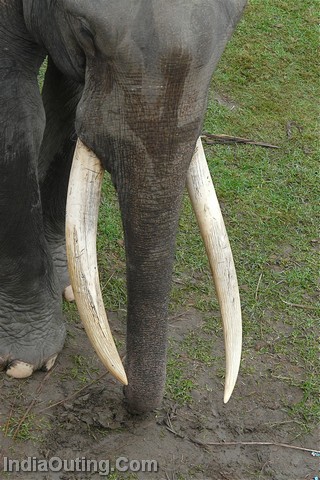

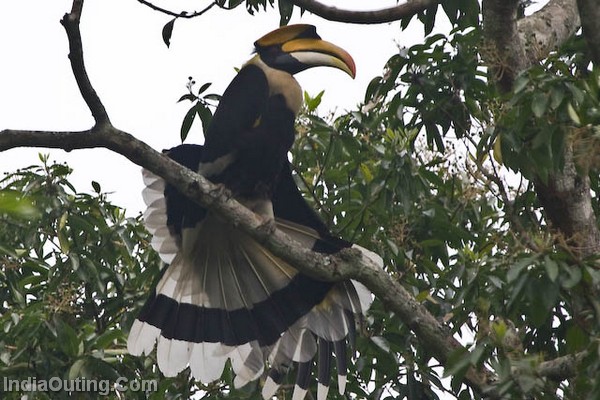
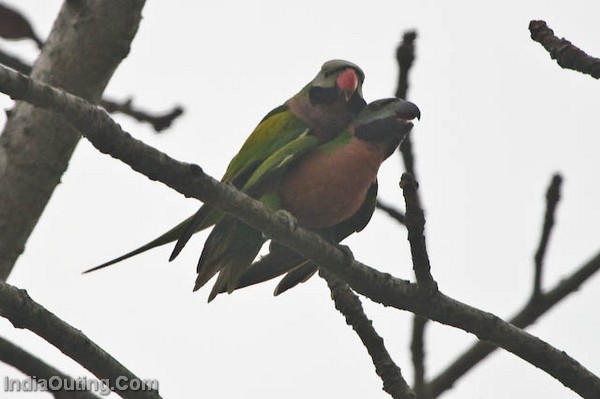




See
FaunaKaziranga contains significant breeding populations of 35 mammalian species, of which 15 are threatened as per the IUCN Red List.The park has the distinction of being home to the world’s largest population of the Great Indian One-Horned Rhinoceros (1,855), Wild Asiatic Water Buffalo (1,666) and Eastern Swamp Deer (468). Significant populations of large herbivores include elephants (1,940), gaur (30) and sambar (58). Small herbivores include the Indian Muntjac, wild boar, and hog deer.Kaziranga is one of the few wild breeding areas outside Africa for multiple species of large cats, such as Indian Tigers and Leopards. Kaziranga was declared a Tiger Reserve in 2006 and has the highest density of tigers in the world (one per five km²), with a population of 86, as per the 2000 census.Other felids include the Jungle Cat, Fishing Cat, and Leopard Cats. Small mammals include the rare Hispid Hare, Indian Gray Mongoose, Small Indian Mongooses, Large Indian Civet, Small Indian Civets, Bengal Fox, Golden Jackal, Sloth Bear, Chinese Pangolin, Indian Pangolins, Hog Badger, Chinese Ferret Badgers, and Particolored flying squirrels. Nine of the 14 primate species found in India occur in the park. Prominent among them are the Assamese Macaque, Capped, Golden Langur, as well as the only ape found in India, the Hoolock Gibbon.Kaziranga’s rivers are also home to the endangered Ganges Dolphin.Kaziranga has been identified by Birdlife International as an Important Bird Area. It is home to a variety of migratory birds, water birds, predators, scavengers, and game birds. Birds such as the Lesser White-fronted Goose, Ferruginous Duck, Baer’s Pochard duck and Lesser Adjutant, Greater Adjutant, Black-necked Stork, and Asian Openbill stork migrate from Central Asia to the park during winter. Riverine birds include the Blyth’s Kingfisher, White-bellied Heron, Dalmatian Pelican, Spot-billed Pelican, Spotted Greenshank, and Black-bellied Tern. Birds of prey include the rare Eastern Imperial, Greater Spotted, White-tailed, Pallas’s Fish Eagle, Grey-headed Fish Eagle, and the Lesser Kestrel.Kaziranga was once home to seven species of vultures, but the vulture population reached near extinction, supposedly by feeding on animal carcasses containing the drug Diclofenac. Only the Indian Vulture, Slender-billed Vulture, and Indian White-rumped Vulture have survived. Game birds include the Swamp Francolin, Bengal Florican, and Pale-capped Pigeon.Other families of birds inhabiting Kaziranga include the Great Indian Hornbill and Wreathed Hornbill, Old World babblers such as Jerdon’s and Marsh Babblers, weaver birds such as the common Baya Weaver, threatened Finn’s Weavers, thrushes such as Hodgson’s Bushchat and Old World warblers such as the Bristled Grassbird. Other threatened species include the Black-breasted Parrotbill and the Rufous-vented Prinia.Two of the largest snakes in the world, the Reticulated Python and Rock Python, as well as the longest venomous snake in the world, the King Cobra, inhabit the park. Other snakes found here include the Indian Cobra, Monocled Cobra, Russell’s Viper, and the Common Krait. Monitor lizard species found in the park include the Bengal monitor and the Water Monitor. Other reptiles include fifteen species of turtle, such as the endemic Assam Roofed Turtle and one species of tortoise, the Brown Tortoise. 42 species of fish are found in the area, including the Tetraodon.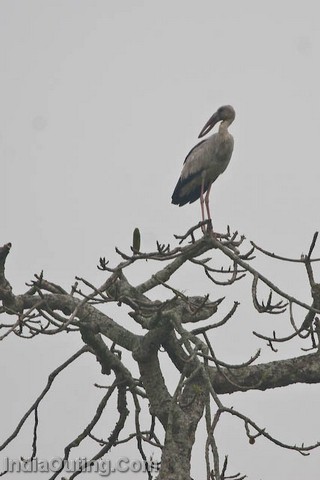
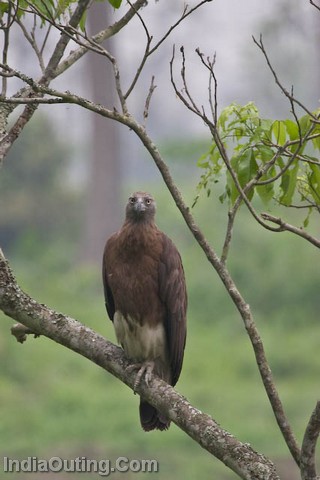
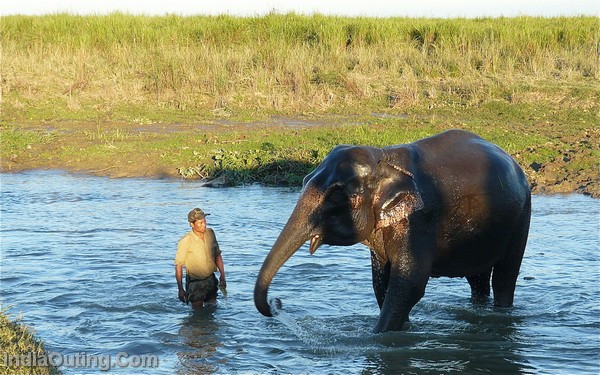
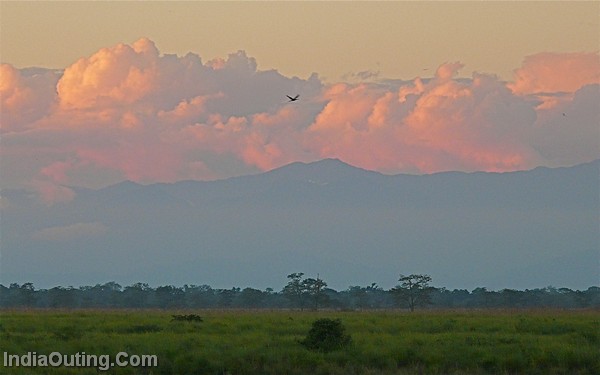 FloraFour main types of vegetation exist in the park. These are alluvial inundated grasslands, alluvial savanna woodlands, tropical moist mixed deciduous forests, and tropical semi-evergreen forests. Based on Landsat data for 1986, percent coverage by vegetation is: tall grasses 41%, short grasses 11%, open jungle 29%, swamps 4%, rivers and water bodies 8%, and sand 6%.There is a difference in altitude between the eastern and western areas of the park, with the western side being at a lower altitude. The western reaches of the park are dominated by grasslands. Tall elephant grass is found on higher ground, while short grasses cover the lower grounds surrounding the beels or flood-created ponds. Annual flooding, grazing by herbivores, and controlled burning maintain and fertilize the grasslands and reeds. Common tall grasses are sugarcanes, spear grass, elephant grass, and the common reed. Numerous forbs are present along with the grasses. Amidst the grasses, providing cover and shade are scattered trees—dominant species including kumbhi, Indian gooseberry, the cotton tree (in savanna woodlands), and elephant apple (in inundated grasslands).Thick evergreen forests, near the Kanchanjhuri, Panbari, and Tamulipathar blocks, contain trees such asAphanamixis polystachya, Talauma hodgsonii, Dillenia indica, Garcinia tinctoria, Ficus rumphii, Cinnamomum bejolghota, and species of Syzygium. Tropical semi-evergreen forests are present near Baguri, Bimali, and Haldibari. Common trees and shrubs are Albizia procera, Duabanga grandiflora, Lagerstroemia speciosa, Crateva unilocularis, Sterculia urens, Grewia serrulata, Mallotus philippensis, Bridelia retusa, Aphania rubra, Leea indica,and Leea umbraculifera.There are many different aquatic floras in the lakes and ponds, and along the river shores. The invasive water hyacinth is very common, often choking the water bodies, but it is cleared during destructive floods. Another invasive species, Mimosa invisa, which is toxic to herbivores, was cleared by Kaziranga staff with help from the Wildlife Trust of India in 2005.
FloraFour main types of vegetation exist in the park. These are alluvial inundated grasslands, alluvial savanna woodlands, tropical moist mixed deciduous forests, and tropical semi-evergreen forests. Based on Landsat data for 1986, percent coverage by vegetation is: tall grasses 41%, short grasses 11%, open jungle 29%, swamps 4%, rivers and water bodies 8%, and sand 6%.There is a difference in altitude between the eastern and western areas of the park, with the western side being at a lower altitude. The western reaches of the park are dominated by grasslands. Tall elephant grass is found on higher ground, while short grasses cover the lower grounds surrounding the beels or flood-created ponds. Annual flooding, grazing by herbivores, and controlled burning maintain and fertilize the grasslands and reeds. Common tall grasses are sugarcanes, spear grass, elephant grass, and the common reed. Numerous forbs are present along with the grasses. Amidst the grasses, providing cover and shade are scattered trees—dominant species including kumbhi, Indian gooseberry, the cotton tree (in savanna woodlands), and elephant apple (in inundated grasslands).Thick evergreen forests, near the Kanchanjhuri, Panbari, and Tamulipathar blocks, contain trees such asAphanamixis polystachya, Talauma hodgsonii, Dillenia indica, Garcinia tinctoria, Ficus rumphii, Cinnamomum bejolghota, and species of Syzygium. Tropical semi-evergreen forests are present near Baguri, Bimali, and Haldibari. Common trees and shrubs are Albizia procera, Duabanga grandiflora, Lagerstroemia speciosa, Crateva unilocularis, Sterculia urens, Grewia serrulata, Mallotus philippensis, Bridelia retusa, Aphania rubra, Leea indica,and Leea umbraculifera.There are many different aquatic floras in the lakes and ponds, and along the river shores. The invasive water hyacinth is very common, often choking the water bodies, but it is cleared during destructive floods. Another invasive species, Mimosa invisa, which is toxic to herbivores, was cleared by Kaziranga staff with help from the Wildlife Trust of India in 2005.